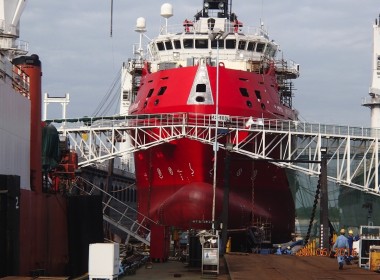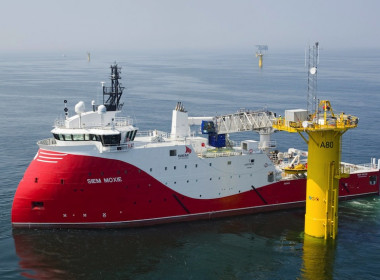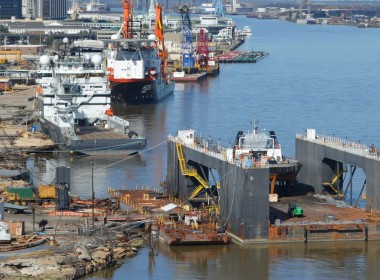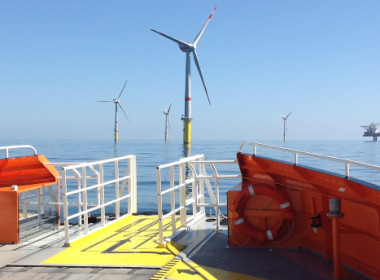COLUMN | Ammonia and LNG: toxic start to the new year for Fortescue, Equinor and the IMO? [Offshore Accounts]

Happy New Year to one and all, though one of the biggest challenges the marine, port, and bunkering industries will face in 2024 is the challenge of future fuels.
You could do my job – the marine fuels op-ed primer
Writing about the problems the marine industry faces is easy – you begin by stating that the industry produces between two and three per cent of total global carbon dioxide emissions, and then highlight that 90 per cent of world trade by volume is transported by sea, so this is actually a very small percentage for a big value add. You might want to highlight that both aviation and server farms produce more missions.
You then state that the International Maritime Organisation (IMO) has set out a new greenhouse gas (GHG) reduction strategy in 2023 (last year!). You summarise that this “strategy” involves committing that the carbon intensity of shipping should decline through improvements in the energy efficiency for all new ships, so that CO2 emissions “per transport work,” as an average across international shipping, falls by at least 40 per cent by 2030, compared to 2008.
Close with the Net Zero aspiration – readers love this stuff?
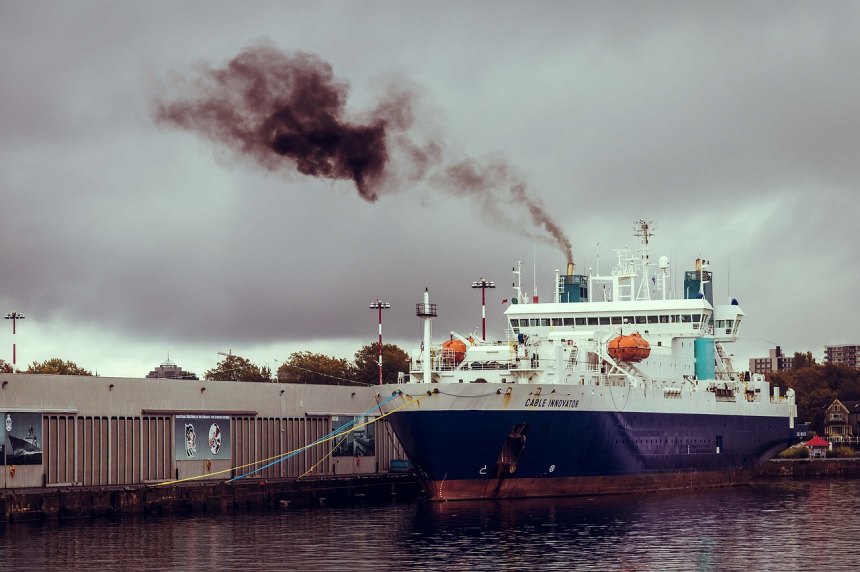
You can observe that the IMO supports the “uptake of zero or near-zero GHG emission technologies, fuels and/or energy sources,” which the august body wants to power at least five per cent, striving for ten per cent, of the energy used by international shipping by 2030. Finally, you conclude that the IMO wants GHG emissions from international shipping to reach net zero “by or around, i.e. close to, 2050, taking into account different national circumstances,” whatever that means.
Helpfully, the IMO strategy includes an “indicative checkpoint” to attempt to “reduce the total annual GHG emissions from international shipping by at least 20 per cent, striving for 30 per cent, by 2030, compared to 2008.”
Job done, you have neatly summarised the problem and outlined the industry regulators’ very non-specific aspirations for an entire industry of tens of thousands of extremely different commercial vessels working all across the world in diverse work scopes. Before you send the piece to the editor, some forward thinking may be necessary. Oh no, that’s tough to do.
How is this going to happen? My colleague Michael Grey wrote an excellent piece last month reminding us of the gap between the aspirations of the IMO and the cold, hard reality of a complex industry with multiple segments and routings.
This is the biggest challenge that the entire shipping industry faces and it’s not at all clear how this will play out. In this piece, we look at progress with liquefied natural gas (LNG) as a marine fuel and how ammonia faces an uphill challenge to become the preferred fuel for the decarbonisation of the marine industry.
Heavy fuel oil will go
One of the benefits of the offshore industry is that none of the rigs or boats in the sector work on heavy fuel oil (HFO), which is the villain of the shipping industry’s efforts to reduce pollution.
HFO is very cheap, very energy dense, and available all around the world. Unfortunately, it is also filthy dirty. The IMO has attempted to reduce sulphur oxides in response to pressure from activists, but even if the SOx output can be reduced with scrubbers or low-sulphur fuels, the problems of carbon emissions, carcinogenic particulates, and nitrogen oxides remain with HFO. Whilst we don’t know which future fuels will be powering newly built containerships, bulkers, and tankers in 2050, the chances are it will probably not be the same heavy fuel oil as today.
Container owners love LNG
As pressure to reduce sulphur emissions increased, container operators moved to order LNG-powered vessels. Two months ago, Jessica Casey, writing in LNG Magazine, highlighted how after CMA CGM made the first order for a large container vessel powered by LNG in 2017, other container lines were quick to follow :
“Hyundai Merchant Marine (HMM) demonstrated early commitment with an order for eight 14,000TEU LNG-powered ships in 2018, while Germany’s Hapag-Lloyd joined as a strong supporter in 2019, subsequently placing a substantial newbuild order for LNG-ready giant containerships in 2021… Israel’s ZIM, primarily chartering its vessels, contracted 10 LNG-ready ships. In 2022, Pacific International Lines ordered new ships equipped with dual-fuel engines that can run on LNG or low-sulfur fuel oil, while the most recent development in 2023 is Yang Ming’s announcement of an order for five 15,000TEU dual-fuel LNG vessels.”
In theory, LNG has many advantages over HFO – in particular, particulate emissions are reduced to zero and sulphur dioxide emissions are near-zero. LNG carriers have run on LNG burn off for decades, so this is proven technology.
All the reasons why coal-fired power generation should be replaced by LNG would also seem to apply to the marine industry. LNG is cleaner, often cheaper, and safer than heavy fuel oil. It is also increasingly widely available at ports around the world.
However, in offshore, LNG has failed. It has had twenty years to prove itself, but take-up has stalled. There is no reason to think that the container operators will have different experiences to the offshore companies which embraced LNG from 2003 onwards.
LNG has failed in offshore

Equinor was the first company to operate an LNG-powered platform supply vessel (PSV) – the 6,000DWT Viking Energy, which entered service in 2003.
When Equinor updated its environmental chartering standards, it notably did not call for any more of its PSV fleet to be LNG-powered. If there were merits to LNG as a marine fuel, you can bet that Equinor would be demanding all Norwegian operators adopt LNG as a fuel. Norway is a perfect test case for LNG adoption – it has its own LNG plants from which to source supply. Equinor uses only a limited number of supply bases, so the bunkering ports are all known, and the company can offer long-term charters backed by environmental incentives.
The main issues with LNG appear to be slippage from the engines; if the fuel is not fully burnt, and methane is 25 times more potent as a greenhouse gas than CO2, so only small levels of slippage completely negate the carbon savings over marine gas oil. This is not a problem in power stations, and LNG has a clear environmental lead over coal. There are also upstream leaks in the production of LNG that increase the overall GHG emissions associated with the fuel from the wellhead to the wake of the ship, however.
Instead of pushing LNG, Equinor now insists that all its chartered supply vessels have diesel-electric power systems with battery hybrid mode and shore power charging, so they can use Norway’s abundant hydro-power produced electricity in port. This is a clear signal to the whole industry on the best carbon reduction initiatives from an operator with deep pockets and wide experience.
Now Equinor is testing ammonia
In late 2021, the European Union and the Norwegian government announced that they were investing over US$27 million to install a potentially revolutionary ammonia-powered fuel cell in conjunction with engine maker Wärtsilä on board Viking Energy. Yes, the LNG-powered vessel would be converted to run on ammonia, which tells you all you need to know about the environmental benefits of LNG!
You will also note that the cost of the conversion is not much less than the US$37.5 million for which Hercules Supply recently ordered a brand new, diesel-electric battery hybrid PSV in China. The cost of the conversion shows the economic challenges of changing to a new fuel system and a brand new technology in just one of the 3,000 offshore support vessels (OSVs) in the world.
The ship is owned and operated by Eidesvik but has been on long-term charter with Equinor for more than two decades now. This year, the EU-funded ShipFC project plans to equip Viking Energy with a 2MW fuel cell running on green ammonia produced from renewable energy.
Note that the ship will be fully ammonia-powered when it enters service with its ammonia fuel cell. Others claim to have got there first, however.
FFI Green Pioneer is the future?
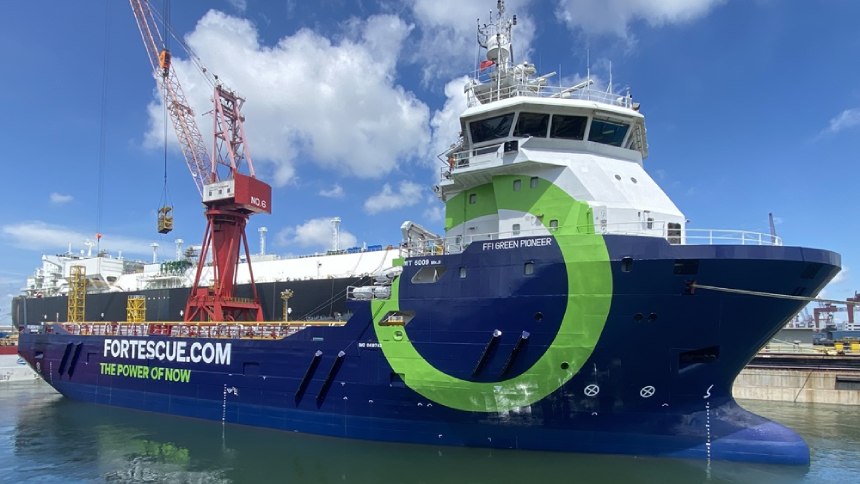
Just over two years ago, in November 2021, MMA Offshore announced it was partnering with Australian industrial player Fortescue Future Industries (FFI) to co-operate on the conversion of the 2010-built, 3300DWT PSV MMA Leveque to ammonia fuel. Then, in March 2022, MMA announced that it had sold the ship to FFI for US$7.75 million. The ship was renamed FFI Green Pioneer, and you can track it via AIS here.
In December 2023, the ship arrived in Dubai at the COP28 climate conference and having apparently converted to ammonia power. The vessel was a year late, but ever the showman, FFI’s founder, chairman and largest shareholder Dr Andrew Forrest claimed it was fully functional.
However, he also said that international regulations would not permit the ship to make international voyages on ammonia, and so he urged regulators to change their stance. He singularly failed to point out what restrictions were in play, and which specific international regulations needed to be changed.
Writing in Clean Technica, FFI said that the company’s PSV was not allowed into the harbour in Dubai.
“In fact,” FFI said, “ammonia powered ships are not permitted in any of the world’s major ports and so while it is in Dubai, it is running on hydro-treated vegetable oil. Fortescue says the ship’s first ammonia fueled voyage is expected in February.
“En route to Dubai, it stopped in Los Angeles but was denied entrance until Dr Forrest got California governor Gavin Newsom on the phone. As Forrest told the Financial Times, Newsom then got on the horn and said, ‘If Dr Forrest wants to bring in a pollution-free ship into the Port of Los Angeles, I want it in, I want it in straightaway.’ That’s the type of pressure which will come on, when solutions are available and people don’t act, Forrest said.”
Clearly, international regulations can’t be overruled by a phone call from the governor of California, so if someone could enlighten me on what the problem is exactly, that would be great.
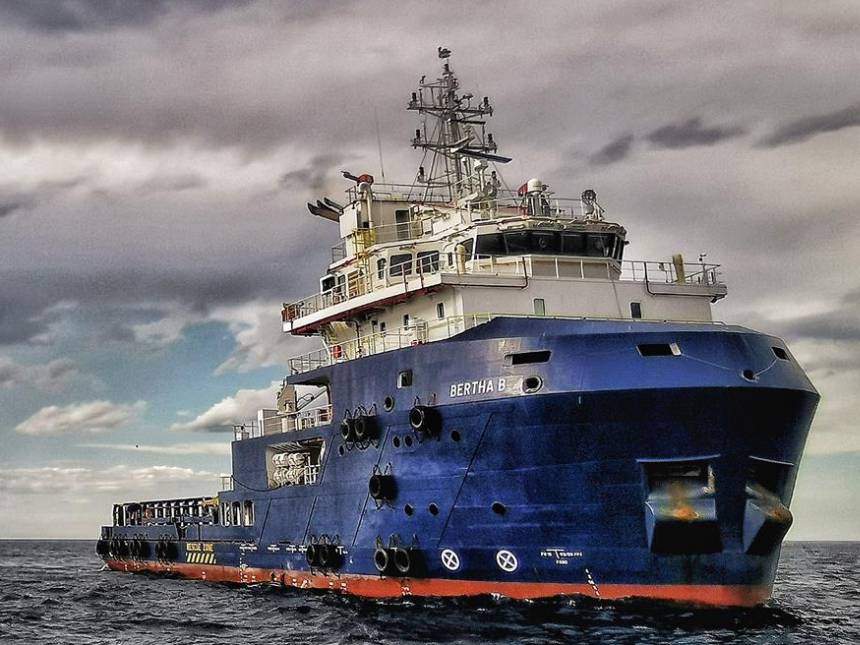
I didn’t quite follow the problem, especially since Dutch and Spanish researchers, at the very same time, were sailing their prototype ammonia powered PSV Bertha B around the Bay of Biscay. Bertha B was built in 2016 and is 60 metres long. It is equipped with a system that transforms ammonia into high-purity hydrogen, and this powers a fuel cell that in turn generates electricity for the ship’s auxiliary services.
The researchers claim in their press release that “the hydrogen production system is not only a world first, but also an example of how technology can contribute to reducing greenhouse gas emissions in maritime transport.” Its membrane reactor technology converts various raw materials into hydrogen, reducing ammonia consumption and optimising space on board the vessel.
Secondly, FFI’s vessel is not at present completely capable of running on ammonia alone, even if Dr Forrest wanted it to, unless I misread the press release. FFI Green Pioneer is being prepared to operate on a mix of ammonia and diesel, a measure that FFI has tested on railway locomotives in Australia.
This planned use of ammonia in an internal combustion engine by FFI is different to the use of ammonia in a fuel cell, as Equinor will trial and as the Spanish project is testing.
The problems of ammonia
Unfortunately, when writing the background to the future fuels problem, you will recall that shipping generates around three per cent of global man-made carbon emissions. You might not be aware that between one and two per cent of total anthropogenic CO2 emissions comes from the existing ammonia industry.
FFI’s plan is that electricity from renewable energy sources like wind and solar would be used to make green ammonia. At the moment, however, there is barely any green ammonia produced anywhere in the world, although FFI has aspirations to ramp up production over the coming decade, backed by extensive government subsidies, as we reported here.
For there to be widespread use of ammonia as a fuel, there needs to be massive investment in renewables to produce green ammonia, rather than the current carbon intensive “brown” ammonia that is made user the Haber-Bosch process, as explained here.
A quick detour into FFI’s odd locomotive project: why?
Fortescue’s approach to the use of ammonia as a transport fuel is unusual to say the least. For some reason, FFI took it upon itself to test ammonia as a fuel for rail locomotives hauling iron ore its sister company in Pilbara in Western Australia.
I don’t understand why the company did not just electrify the rail engines rather than mess around with ammonia and diesel mixes to power them. All over Europe, you can witness functional zero-emission railways for both passengers and cargo, where countries such as France, Sweden, Norway, Finland, Switzerland, and Austria use mixes of hydro and nuclear power for their rail networks. These national rail operators already have lower emissions than the Fortescue ammonia-diesel trains anyway, and there is no reason Fortescue’s mines could not electrify operations in Australia with green power rather than use ammonia mixed with diesel.
Ironically, FFI chose to partner with German national rail operator Deutsche Bahn to develop its ammonia-hydrogen powered locomotives. Let us not forget that Germany is the one country in Europe that has increased its carbon emissions by generating more electricity from coal after foolishly phasing out its nuclear power plants to appease the green lobby.
I suspect the solution for rail is not replacing diesel with ammonia, but using electric trains and replacing coal-fired power stations with renewables, nuclear, and even transitional gas.
Don’t you know that you’re toxic?
The primary danger from ammonia, however, is its toxicity. Andrew Forrest has claimed over and over that FFI Green Pioneer is a pollution-free vessel.
“If [FFI Green Pioneer] was powered by fuels that are going to destroy this planet, destroy the future of your own children — diesel, bunker sea oil — then it’s ‘come on in, the water’s fine!'” Dr Forrest said. “‘Oh, no, a pollution-free ship? Stop right there, don’t come in!'”
It is pollution-free, until it runs aground, collides with another vessel, or suffers a loss of integrity in its ammonia bunker tanks.
Conclusion: methanol leads for now
Drewry, the container shipping consultancy, explains how methanol is currently ahead as the decarbonisation fuel, as it is cheaper and safer than ammonia. But even so, green methanol will likely be 300 per cent more expensive than standard low-sulphur bunker fuel, so there is a huge cost problem for at least five years or more.
The tests for ammonia in the next five years will be critical. Dr Forrest is characteristically talking up his book, as FFI is planning major investments in green ammonia as a future fuel. He may be able to push through ammonia-powered bulk carriers for his exports, and demonstrate the safety and efficiency of the fuel for the biggest vessels in the world. Nonetheless, the widespread adoption of ammonia will require a massive reconfiguration of the world’s ammonia production away from Bosch-Haber to renewables, and a reconfiguration of the entire marine fuel distribution system. This is likely to take far longer than expected, and to cost far more than planned.
In short, we don’t know which will be the dominant future fuel for the marine industry, and likely different segments of the industry will adopt different power sources. For short-haul shipping, batteries could well become dominant. For containers, the backing of Maersk for methanol may be critical. For car carriers, bulk carriers, and tankers, no one knows at the moment, although there are already methanol-powered ships in those categories with engines that can run on both diesel and methanol without modification. This way, the owners can claim they have the capability to be green, instead of having to mimic FFI by having a PSV sailing to Dubai powered by regular MGO, albeit sourced sustainably from recycled vegetable fats and oils, but with the ability to run two of its engines on a diesel-ammonia mix if it were available.
Let’s end with either scare-mongering or a realistic statement of possible risks
The Last Word goes to Rachel Parkes writing in Recharge in 2022 on the safety problems ammonia faces. When you read a headline like “Burns, blindness and agonising deaths: is it safe to ship hydrogen-derived ammonia around the world?” you can see why methanol enjoys the lead it has, and what a difficult job the shipping industry is going to have when the first major marine pollution incident involving ammonia occurs.
An ammonia spill, Ms Parkes observed, could “sterilise cubic miles of ocean.” Having largely fixed its crude oil spill and bunker oil spill problems, after years of painful and destructive lessons learned, the marine industry really doesn’t need another expensive and environmentally destructive series of mishaps with a new and supposedly green fuel that also happens to be highly toxic.
Branding an ammonia powered ship as “pollution-free” is a very risky strategy, Dr Forrest should note. Ammonia may be a viable marine fuel, but over-hyping the case does not help anyone. The shipping industry’s marine fuel challenges are many, and there will be no easy or cheap solutions.
In the next decade, supply vessel owners and oil companies should follow Equinor’s lead and follow through on fully implementing diesel-electric battery hybrid PSVs with shore power. Then we can look and learn from the experiments with ammonia, methanol, full battery power, and even nuclear.
It is going to be an interesting run through to Net Zero in 2050 – or thereabouts.
Background reading
We first examined the state of play with Viking Energy, Fortescue, ammonia and CMB’s hydrogen power in December 2021, here.
Bureau Veritas summarises the pros and cons of ammonia really well.
This academic paper from Energy Strategy Reviews in 2022 summarises the pros and cons of the different marine future fuels, including ammonia, and sets out the long history of the IMO’s efforts to reduce the shipping industry’s environmental footprint.
Finally, the theme song for ammonia as a marine fuel should perhaps be Britney Spears’ Toxic. The video really harks back to a golden age of air travel.


